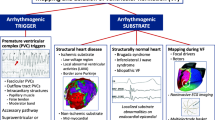Abstract
Atrial fibrillation, the most common of all sustained cardiac arrhythmias can be cured by Surgical atriotomies or linear RF catheter ablation. We have investigated the role of focal RF ablation in paroxysmal atrial fibrillation
Methods: sixteen patients with focal atrial fibrillation (extrasystoles, atrial tachycardia and atrial fibrillation due to the same focus firing irregularly at different rates) and 45 with common AF initiated by extrasystolic foci were included. The ablation site was determined on the basis of earliest bipolar activity relative to a stable atrial electrogram reference or to the P wave onset during atrial fibrillation initiation.
Results: All the patients with focal atrial fibrillation were treated with a mean of 5 ± 4 RF applications delivered on a right atrial site (n = 4) or on a pulmonary venous site (n = 13), (one patient had 2 foci). Sixty nine foci (located in the pulmonary veins in 94%) were identified in the 45 patients with common atrial fibrillation initiated by extrasystoles. They were ablated with a mean of 4.5 ± 2 RF applications. Using a mean follow up of 8 ± 6 months, 28/45 (62%) were cured without antiarrhythmic drugs.
Conclusion: Pulmonary veins play an important role in paroxysmal atrial fibrillation. They are the most frequent source of focal atrial fibrillation and of initiating foci amenable to RF ablation.
Similar content being viewed by others
References
Kopecky SL, Gersh BJ, McGoon, et al. The natural history of lone atrial fibrillation: A population-based study over three decades. N Engl J Med 1987;317:669–674.
Prystowsky EN, Benson DW, Fuster V, et al. Management of patients with atrial fibrillation: A statement for healthcare professionals from the subcommittee on electrocardiography and electrophysiology, American Heart Association. Circulation 1996;93:1262–1277.
Wellens HJJ. Atrial fibrillation, the last big hurdle in treating supraventricular tachycardia. N Engl J Med 1984;331:944–945.
Cox JL, Canavan TE, Schuessler RB, et al. The surgical treatment of atrial fibrillation II: Intraoperative electrophysiologic mapping and description of the electrophysiologic basis of atrial flutter and fibrillation. J Thorac Cardiovasc Surg 1991;101:406–426.
Cox JL, Boineau JP, Schuessler RB, Kater KM, Lappas DG. Five year experience with the Maze procedure for atrial fibrillation. Ann Thorac Surg 1993;56:814–824.
Defauw JJ, Guiraudon GM, Van Hemel NM, Vermeulen FE, Kingma JH, de Bakker JM. Surgical therapy of paroxysmal atrial fibrillation with the corridor operation. Ann Thorac Surg 1992;53:564–571.
Shyu KG, Cheng JJ, Chen JJ, et al. Recovery of atrial function after atrial compartment operation for chronic atrial fibrillation in mitral valve disease. J Am Coll Cardiol 1994;24:392–398.
Kosakai Y, Kawaguchi AT, Isobe F. Modified Maze procedure for patients with atrial fibrillation undergoing simultaneous open heart surgery. Circulation 1995;92(Suppl II):II-359-II-364.
Avitall B, Hare J, Mughal K, et al. Ablation of atrial fibrillation in a dog model. J Am Coll Cardiol 1994;484:276A.
Elvan A, Pride HP, Eble JN, Zipes DP. Radiofrequency catheter ablation of the atria reduces inducibility and duration of atrial fibrillation in dogs. Circulation 1995;91:2235–2244.
Morillo CA, Klein GJ, Jones DL, Guiraudon CM. Chronic rapid atrial pacing: Structural, functional and electrophysiologic characteristics of a new model of sustained atrial fibrillation. Circulation 1995;91:1588–1595.
Haines DE, McRury IA. Primary atrial fibrillation ablation (PAFA) in a chronic atrial fibrillation model. Circulation 1995;92:I-265.
Sih HJ, Berbari EJ, Zipes DP. Epicardial maps of atrial fibrillation after linear ablation lesions. J Cardiovasc Electrophysiol 1997;8:1046–1054.
Swartz JF, Pellersels G, Silvers J, Patten L, Cervantez D. A catheter-based curative approach to atrial fibrillation in humans. Circulation 1994;90(4)Part 2:I-335.
Haïssaguerre M, Jaïs P, Shah DC, et al. Right and left atrial radiofrequency catheter therapy of paroxysmal atrial fibrillation. J Cardiovasc Electrophysiol 1996;7:1132–1144.
Haïssaguerre M, Marcus FI, Fischer B, Clémenty J. Radiofrequency catheter ablation in unusual mechanisms of atrial fibrillation: Report of three cases. J Cardiovasc Electrophysiol 1994;5:743–751.
Jaïs P, Haïssaguerre M, Shah DC, et al. A focal source of atrial fibrillation treated by discrete radiofrequency ablation. Circulation 1997;95:572–576.
Haïssaguerre M, Jaïs P, Shah DC, et al. Spontaneous initiation of atrial fibrillation by ectopic beats originating in the pulmonary veins. N Engl J Med 1998;339:659–666.
Moe GK, Rheinboldt WC, Abildskov JA. A computer model of atrial fibrillation. Am Heart J 1964;200–220.
Konings KTS, Kirschhof CJHJ, Smeets JRLM, Wellens HJJ, Penn O, Allessie MA. High-density mapping of electrically induced atrial fibrillation in humans. Circulation 1994;89:1665–1680.
Allessie MA, Rensma PL, Brugada J, Smeets JLRM, Penn O, Kirchhof CJHJ. Pathophysiology of atrial fibrillation. In: Zipes DP, Jalife J, eds. Cardiac Electrophysiology: From Cell to Bedside. Philadelphia: WB Saunders, 1990:548–559.
Wharton JM, Vergara I, Shander G, Bahnson TD, Sorrentino RA. Identification and ablation of focal mechanisms of atrial fibrillation Circulation 1998;98(17):I-18 (Abstract).
Zipes DP, Knope RF. Electrical properties of the thoracic veins. Am J Cardiol 1972;29:372–376.
Spach MS, Barr RC, Jewett PH. Spread of excitation from the atrium into thoracic veins in human beings and dogs. Am J Cardiol 1972;30:844–854.
Nathan H, Eliakim M. The junction between the left atrium and the pulmonary veins. An anatomic study of human hearts. Circulation 1966;34:412–422.
Ito M, Arita M, Saeki K et al. Functional properties of sinocaval conduction. Jap J Physiol 1967;17:174–189.
Robbins IM, Colvin EV, Doyle TP, et al. Pulmonary vein stenosis after catheter ablation of atrial fibrillation. Circulation 1998;98:1769–1775.
Author information
Authors and Affiliations
Rights and permissions
About this article
Cite this article
Jaïs, P., Shah, D.C., Haïssaguerre, M. et al. Atrial Fibrillation: Role of Arrhythmogenic Foci. J Interv Card Electrophysiol 4 (Suppl 1), 29–37 (2000). https://doi.org/10.1023/A:1009857926782
Issue Date:
DOI: https://doi.org/10.1023/A:1009857926782




